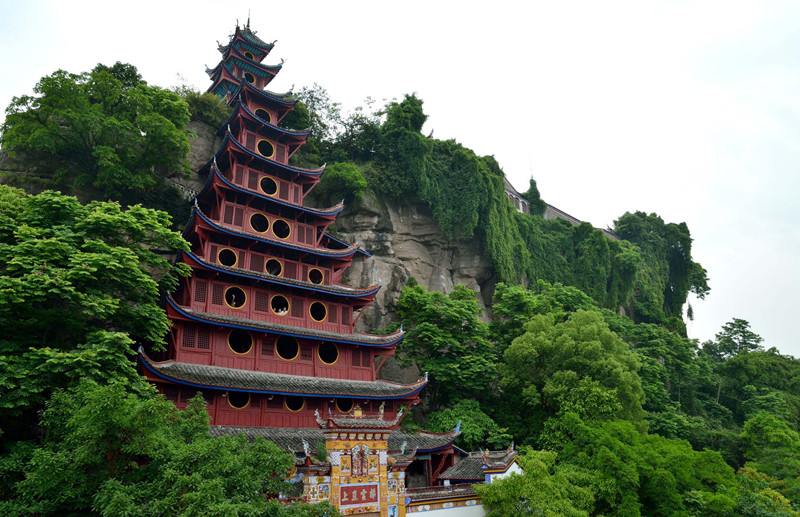Shibaozhai, Literally means Stone Treasure Fortress, Located in ZhongCounty, at the south bank of the Yangtze River, 278 km away from Chongqing. Built in Qing Dynasty in 1750, this 100-foot high red pagoda stands in front of a mountainous area full of shrubs and trees, with a glorious backdrop from afar. Stands on the riverside, the wooden architecture was built by catch upon a rectangular rock with sheer cliffs with a height of 56 meters and 12 stories. Every floor of the wooden structure contains interesting artifacts. Each of the 12 floors of Shibaozhai is dedicated to a famous general of the Three Kingdoms period (220-265AD), a local scholar or a remowned Chinese poet.
Visitors of the temple can climb up the pagoda stairs to experience the spectacular sight from above. Although the stairs in the temple are steep, tourists who want to go up can take an exit route that can be found outside the pagoda. Its stairs are more spacious and less steep than the stairs inside the temple.
Located on the south bank of the Yangtze River, it was first built during the Qing Dynasty in 1650. As one of the most spectacular sites along the river, this 12-story 56m wooden red pavilion hugs a sheer rectangular cliff. It consists of three parts: the entrance gate, a nine-story wooden pavilion and a small temple at the top.
On its yellow-glazed entrance gate is an inscription inviting the visitor to climb a ladder and ascend into a ‘Little Fairyland’ (the top temple). The top temple was built during the reign of Emperor Qianlong. Originally, the top temple was inaccessible because of its elevation but later an iron chain was attached to the cliff so visitors could access it. In 1819, the nine-story red wooden pavilion was added so that monks and visitors to the temple would not have to suffer the discomforts of the ascent by using chains. Designers also built interior spiral staircase to make climbing more convenient.
Top Temple
At the top appears a stone terrace of 1200 square meters(1440 square yards). Visitors can get a panoramic view of the winding river, the village and the countryside and feel immersed in a sea of clouds. A series of halls stand in the middle of the terrace with a well in Ganyu Palace at the top of Jade Seal Hill. The well is called Duck Hole. It was said that during late spring, if you dropped a duck down the hole, it would quickly reappear swimming in the Yangtze. Another bit of local gossip said that in the past monks apparently drew their drinking water from this hole by using a pipe made of bamboo.
The spirit wall in the temple’s main hall is constructed of excavated Han dynasty (206 BC-AD 220) bricks. The hall behind is dedicated on the right to Generals Zhang Fei and Yan Yan (see Zhongxian) of the Three Kingdoms, and on the left to General Qin Liangyu (1576-1648) who fought bravely against the Manchu forces. A mural depicts the goddess Nuwo repairing the sky. Fossils of fish and a tail section of a dinosaur found by the river’s edge are on exhibit in the hall.
In the rear hall are the remains of the Rice Flowing Hole. Legend has it that long ago just enough husked rice would flow from the small hole each day for the needs of the monks. One day a greedy monk attempted to get more and chiseled a bigger hole and so the flow of rice ceased forever.Many of tourist cruise ships dock at Shibaozhai for a few hours’ visit.
